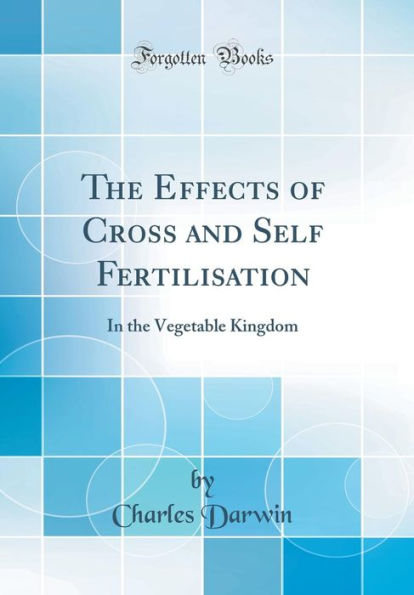The Effects of Cross and Self Fertilisation: In the Vegetable Kingdom (Classic Reprint)
Excerpt from The Effects of Cross and Self Fertilisation: In the Vegetable Kingdom
There is weighty and abundant evidence that the flowers of most kinds of plants are constructed so as to be occasionally or habitually cross-fertilised by pollen from another flower, produced either by the same plant, or generally, as we Shall hereafter see reason to believe, by a distinct plant. Cross-fertilisa tion is sometimes ensured by the sexes being separated, and in a large number of cases by the pollen and stigma of the same flower being matured at different times. Such plants are called dichogamous, and have. Been divided into two sub-classes: proterandrous species.
About the Publisher
Forgotten Books publishes hundreds of thousands of rare and classic books. Find more at www.forgottenbooks.com
This book is a reproduction of an important historical work. Forgotten Books uses state-of-the-art technology to digitally reconstruct the work, preserving the original format whilst repairing imperfections present in the aged copy. In rare cases, an imperfection in the original, such as a blemish or missing page, may be replicated in our edition. We do, however, repair the vast majority of imperfections successfully; any imperfections that remain are intentionally left to preserve the state of such historical works.
1100025391
There is weighty and abundant evidence that the flowers of most kinds of plants are constructed so as to be occasionally or habitually cross-fertilised by pollen from another flower, produced either by the same plant, or generally, as we Shall hereafter see reason to believe, by a distinct plant. Cross-fertilisa tion is sometimes ensured by the sexes being separated, and in a large number of cases by the pollen and stigma of the same flower being matured at different times. Such plants are called dichogamous, and have. Been divided into two sub-classes: proterandrous species.
About the Publisher
Forgotten Books publishes hundreds of thousands of rare and classic books. Find more at www.forgottenbooks.com
This book is a reproduction of an important historical work. Forgotten Books uses state-of-the-art technology to digitally reconstruct the work, preserving the original format whilst repairing imperfections present in the aged copy. In rare cases, an imperfection in the original, such as a blemish or missing page, may be replicated in our edition. We do, however, repair the vast majority of imperfections successfully; any imperfections that remain are intentionally left to preserve the state of such historical works.
The Effects of Cross and Self Fertilisation: In the Vegetable Kingdom (Classic Reprint)
Excerpt from The Effects of Cross and Self Fertilisation: In the Vegetable Kingdom
There is weighty and abundant evidence that the flowers of most kinds of plants are constructed so as to be occasionally or habitually cross-fertilised by pollen from another flower, produced either by the same plant, or generally, as we Shall hereafter see reason to believe, by a distinct plant. Cross-fertilisa tion is sometimes ensured by the sexes being separated, and in a large number of cases by the pollen and stigma of the same flower being matured at different times. Such plants are called dichogamous, and have. Been divided into two sub-classes: proterandrous species.
About the Publisher
Forgotten Books publishes hundreds of thousands of rare and classic books. Find more at www.forgottenbooks.com
This book is a reproduction of an important historical work. Forgotten Books uses state-of-the-art technology to digitally reconstruct the work, preserving the original format whilst repairing imperfections present in the aged copy. In rare cases, an imperfection in the original, such as a blemish or missing page, may be replicated in our edition. We do, however, repair the vast majority of imperfections successfully; any imperfections that remain are intentionally left to preserve the state of such historical works.
There is weighty and abundant evidence that the flowers of most kinds of plants are constructed so as to be occasionally or habitually cross-fertilised by pollen from another flower, produced either by the same plant, or generally, as we Shall hereafter see reason to believe, by a distinct plant. Cross-fertilisa tion is sometimes ensured by the sexes being separated, and in a large number of cases by the pollen and stigma of the same flower being matured at different times. Such plants are called dichogamous, and have. Been divided into two sub-classes: proterandrous species.
About the Publisher
Forgotten Books publishes hundreds of thousands of rare and classic books. Find more at www.forgottenbooks.com
This book is a reproduction of an important historical work. Forgotten Books uses state-of-the-art technology to digitally reconstruct the work, preserving the original format whilst repairing imperfections present in the aged copy. In rare cases, an imperfection in the original, such as a blemish or missing page, may be replicated in our edition. We do, however, repair the vast majority of imperfections successfully; any imperfections that remain are intentionally left to preserve the state of such historical works.
34.31
In Stock
5
1

The Effects of Cross and Self Fertilisation: In the Vegetable Kingdom (Classic Reprint)
504
The Effects of Cross and Self Fertilisation: In the Vegetable Kingdom (Classic Reprint)
504
34.31
In Stock

Product Details
| ISBN-13: | 9780267568277 |
|---|---|
| Publisher: | Fb&c Ltd |
| Publication date: | 02/02/2018 |
| Pages: | 504 |
| Product dimensions: | 5.98(w) x 9.02(h) x 1.06(d) |
About the Author

From the B&N Reads Blog
